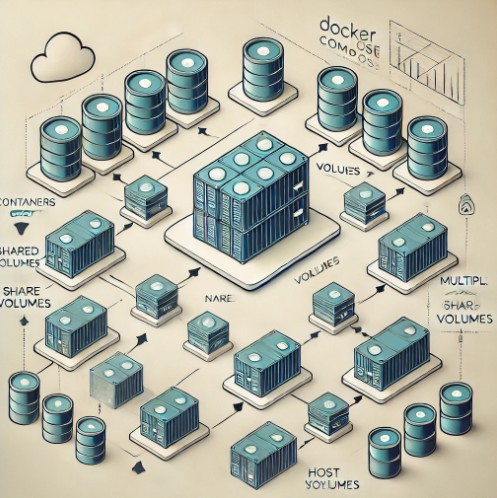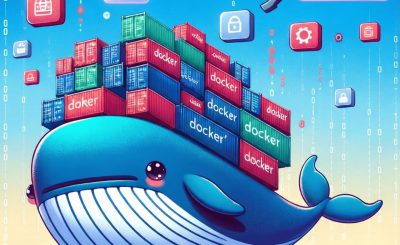Table of Contents
Introduction
Docker Compose has revolutionized containerized application management by simplifying multi-container setups. Among its many features, volumes stand out as an essential mechanism for managing persistent data in Docker containers. Whether you are running databases, handling logs, or managing user uploads, Docker Compose volumes ensure data consistency and ease of access across containers. This guide dives deep into using Docker Compose volumes, providing practical examples, best practices, and solutions to common challenges.
What Are Docker Compose Volumes?
Docker Compose volumes are storage spaces external to containers, used for persisting data even after containers are stopped or restarted. They enable data sharing between multiple containers and maintain data integrity over the lifecycle of an application. By using volumes, you can:
- Decouple data storage from application logic.
- Avoid data loss during container restarts.
- Share data seamlessly between containers.
Key Benefits of Docker Compose Volumes
- Data Persistence: Volumes ensure data remains intact even after container recreation.
- Performance: Native volume drivers offer superior performance over bind mounts.
- Flexibility: Support for multiple volume types, including local and remote storage.
Getting Started with Docker Compose Volumes
Basic Syntax
Volumes in Docker Compose are defined under the volumes key in the docker-compose.yml file. Here’s the general syntax:
version: '3.9'
services:
service_name:
image: image_name
volumes:
- volume_name:/path/in/container
volumes:
volume_name:
driver: localExample 1: Simple Volume Usage
Let’s start with a basic example where a volume is used to store database data.
version: '3.9'
services:
database:
image: mysql:latest
environment:
MYSQL_ROOT_PASSWORD: example
volumes:
- db_data:/var/lib/mysql
volumes:
db_data:
driver: localExplanation:
- The
db_datavolume is mounted to/var/lib/mysqlin thedatabasecontainer. - Data stored in the database persists even after the container stops.
Example 2: Sharing Data Between Containers
version: '3.9'
services:
app:
image: my-app:latest
volumes:
- shared_data:/app/data
worker:
image: my-worker:latest
volumes:
- shared_data:/worker/data
volumes:
shared_data:
driver: localExplanation:
- Both
appandworkerservices share theshared_datavolume. - This setup allows seamless data exchange between the two containers.
Example 3: Bind Mounts for Local Development
Bind mounts are ideal for local development, where changes to files need immediate reflection in containers.
version: '3.9'
services:
web:
image: nginx:latest
volumes:
- ./html:/usr/share/nginx/htmlExplanation:
- The
./htmldirectory on the host is mounted to/usr/share/nginx/htmlin the container. - Any updates to files in
./htmlare instantly visible in the container.
Advanced Scenarios with Docker Compose Volumes
Using Named Volumes with Custom Drivers
version: '3.9'
services:
data_service:
image: data-image:latest
volumes:
- custom_volume:/data
volumes:
custom_volume:
driver: local
driver_opts:
type: none
o: bind
device: /path/to/custom/dirExplanation:
- The
custom_volumeis configured with specific driver options to use a custom directory on the host. - Offers greater control over volume behavior.
Managing Volume Lifecycle
- Create Volumes:
docker volume create volume_name
- List Volumes:
docker volume ls
- Inspect Volumes:
docker volume inspect volume_name
- Remove Volumes:
docker volume rm volume_name
Best Practices for Using Docker Compose Volumes
- Use Named Volumes for Persistent Data: Provides better management and reusability.
- Avoid Sensitive Data in Bind Mounts: Secure sensitive information using encrypted volumes or environment variables.
- Regularly Backup Volume Data: Use tools like
taror specialized backup solutions.
FAQ: Docker Compose Volumes
What is the difference between volumes and bind mounts?
- Volumes: Managed by Docker, offer better performance and security.
- Bind Mounts: Directly map host directories, suitable for development environments.
Can I use Docker Compose volumes with cloud storage?
Yes, volumes can be configured to use cloud storage backends like AWS, Azure, or Google Cloud using plugins.
How do I clean up unused volumes?
Use the following command:
docker volume pruneCan I change the volume driver after creation?
No, you must recreate the volume to change its driver.

External Resources
Conclusion
Docker Compose volumes are indispensable for managing persistent data in containerized applications. From simple data storage to complex multi-container setups, volumes provide a robust and flexible solution. By understanding their usage and following best practices, you can enhance your Docker workflows and ensure data reliability across your applications. Start implementing Docker Compose volumes today and unlock the full potential of containerization! Thank you for reading the DevopsRoles page!

